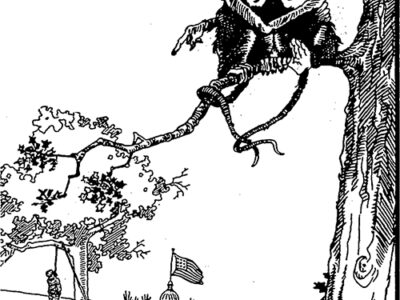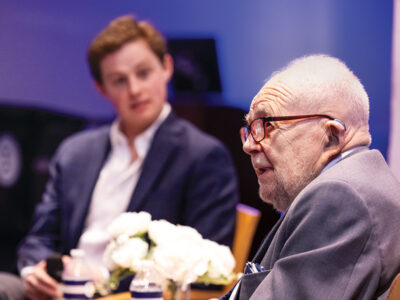
How the president of a Black college ended up on the wrong side of W. E. B. Du Bois—and history.
On July 19, 1924, Fisk University president Fayette Avery McKenzie GrEd1908 announced that the all-Black college in Nashville, Tennessee, had successfully completed a million-dollar fundraising campaign, yielding the largest endowment ever amassed by a Black college.
Less than a year later, he would be forced to resign—a victim, in a way, of his own fundraising success.
Born in 1872 in rural Montrose, Pennsylvania, McKenzie attended Lehigh University and taught for several years at Juniata College in Huntingdon, Pennsylvania. He then moved to Philadelphia, where he taught at a prep school and took classes at Penn.
By the standards of his day, McKenzie was progressive on racial matters. His doctoral thesis examined the plight of Native Americans forced to relocate to the Plains, and he was a founder of the first national organization to advocate for indigenous rights, the Society for American Indians. When he was appointed Fisk president, the old Nashville Banner newspaper noted that “Prof. McKenzie’s home training and his university studies led him to feel an especial interest in race problems.”
Founded by Christian missionaries six months after the Civil War ended, Fisk Free Colored School was open to formerly enslaved people of any age and, its founders declared, dedicated to “the highest standards, not of Negro education, but of American education at its best.” It was named for Clinton Fisk, assistant commissioner of the Freedmen’s Bureau in Tennessee, who contributed $30,000 to the school and made available a former Union Army barracks for its first classes. In 1867, the school was incorporated as Fisk University. Nine years later, the school’s first permanent building, Jubilee Hall, opened. It was named for the school’s famous Jubilee Singers, who toured relentlessly to raise money for Fisk.
But by the time McKenzie was appointed the school’s fourth president in 1915, Fisk was in dire financial straits; the Jubilee Singers alone could no longer support the school. So McKenzie began soliciting large contributions, mostly from wealthy white people. A group of Nashville businessmen raised $50,000, representing “the first time that any such sum has been contributed by any Southern city for any type of Negro education,” according to the Banner. But there were strings attached: the donors wanted McKenzie to suppress militancy and make Fisk a training ground for “the right type of colored leaders,” as Victor Luckerson characterized it in his 2023 book Built from the Fire. There would be no room for the “freethinking ideals of the New Negro movement” on campus, Luckerson also wrote. In addition to the arts and sciences, they wanted Fisk students to be taught their place under Jim Crow.
McKenzie complied. In 1916 he closed the student newspaper. Two years later he abolished the student council. He also banned most extracurricular activities, including the baseball and track teams. He imposed curfews and a strict dress code and did not allow men and women to fraternize on campus. Students who defied his rules were accused of being Bolshevists and summarily expelled.
As the years passed, McKenzie seemed to grow more sympathetic to the racial attitudes of his donors. He joined all-white organizations like the Kiwanis club and the Chamber of Commerce. He segregated seating at performances of the Jubilee Singers, and the group was required to enter venues through back doors.
Critics said he also grew more tyrannical. In 1920, he banned the NAACP from campus. According to the Black historian Alrutheus Ambush Taylor, who wrote about Fisk University in the early 1950s, “[McKenzie] exceeded the limits of necessity in conforming to the prevailing Southern ideas concerning the Negro.”
In the years immediately following World War I, opposition to McKenzie grew among Fisk students, some of whom were returning veterans. Things came to a head in the spring of 1924, when Fisk’s most distinguished alumnus, W. E. B. Du Bois, returned to his alma mater to deliver a speech to alumni during commencement week. In his speech, Du Bois, the prominent author and civil rights activist whose daughter was attending Fisk at the time, excoriated McKenzie and his policies. “You cannot have an institution of learning where there is no real chance at self-expression,” said Du Bois, who began research on The Philadelphia Negro during a one-year appointment in 1896 at Penn, where W. E. B. Du Bois College House was later created in his honor [“House of Resiliency,” Nov|Dec 2022]. He subsequently took his campaign to the pages of the NAACP’s magazine, The Crisis, which he edited. “Men and women of Black America: Let no decent Negro send his child to Fisk until Fayette McKenzie goes,” Du Bois wrote.
Over the next year, Fisk students staged a series of rallies demanding McKenzie’s resignation. Edward L. Goodwin was one of the students who organized the protests. The grandson of a slave, Goodwin was born in Water Valley, Mississippi, in December 1902, but moved with his family to Greenwood, a prosperous Black neighborhood in Tulsa, Oklahoma, in 1914. He attended Booker T. Washington High School, though his senior year was cut short when whites attacked Greenwood, killing scores of Blacks, and looting and burning dozens of buildings, effectively destroying the community. “I was in the play the night of May 31, 1921,” he recalled 50 years later. “The principal dismissed us by announcing that there was trouble, and that everyone was to go home. That was the night the riot began.”
The following year, Goodwin enrolled at Fisk.
In an article titled “Reasons Why We as Students Dislike Fisk,” Goodwin laid out the students’ complaints. “I would say that we as students feel that the element of oppression is being handed down upon us by the ‘Head’ of the institution, i.e. we feel that the ‘Head’ of Fisk practices autocracy; consequently we feel that there is no democracy,” he wrote. “For this reason we feel that we as students are being oppressed.”
A senior studying business, Goodwin belonged to a group that represented the student body in discussions with McKenzie and the board of trustees. In a November 1924 meeting of the trustees—at which McKenzie was lauded for achieving the million-dollar endowment—the group presented a list of grievances, and requested that fraternities and sororities be reinstated, along with student publications and the baseball and track teams. “Give us the milk of human kindness and we shall never bite the maternal breast,” the group wrote in the petition; “feed us the venom of distrust—our very KISSES shall poison.”
The board approved several requests, but McKenzie refused to implement the changes. “Under the very peculiar conditions at Fisk and in most colored schools,” he explained unapologetically, “great authority and substantially the bulk of the initiative must be centered in the president.”
The battle reached its climax on the evening of Wednesday, February 4, 1925. After attending chapel, the students returned to their dormitories. Then a disturbance began. Windows were broken in Livingstone Hall, one of the men’s dormitories. Then a group of students marched around the campus banging pots and pans and singing in unison, “Before I’d be a slave, I’d be buried in my grave!”
McKenzie called in the (all-white) Nashville police department to quell the disturbance, and more than 30 officers responded, wielding clubs and guns. Some reports say shots were fired, but by whom was never ascertained. McKenzie gave the police the names of seven students he believed were behind the unrest. The seven, including Edward Goodwin, were arrested and charged with inciting a riot.
The next morning, McKenzie issued a statement defending his decision to call in the police. “Open rebellion and public riot cannot be the agency for redress of grievances,” the statement read. He also defended his fundraising philosophy. “Grave suspicions are being fostered that we are selling our principles for money and thereby meeting the desires of capitalism to control Negro education,” he said. “There is strong antagonism to the principles of conciliation and co-operation which Fisk has always believed the necessary consequence of Christianity.”
Goodwin and the six other “ringleaders” were hauled before a Nashville judge later that day. McKenzie was in the courtroom as well, and the judge asked him if he had any proof the seven young men were responsible for the events of the previous night. “It’s a long story, your honor,” McKenzie answered. “These men have spoken against my administration and my policies all during the year. While I had no actual proof they were in the disturbance, I felt that they might be behind this or anything of its nature.”
The charges against Goodwin and the others were ultimately dismissed.
On Friday, February 6, Fisk students went on strike. Within a week, roughly 80 percent of the school’s approximately 330 students had left the campus and returned home. McKenzie was still holding firm—he was quoted as saying “no changes in the rules and administration will be made under pressure”—but it was now clear his days at Fisk were numbered. The controversy was making news nationwide, and the coverage did not reflect favorably on Fisk.
On April 16, 1925, McKenzie finally quit, citing the approach of his 10th anniversary as Fisk president in the letter of resignation he submitted to the board of trustees. “I have given perhaps the best 10 years of my life to that service during one of the most difficult decades in the history of the world,” he wrote. “What I have accomplished I must leave to you and others familiar with my work to judge.”
“Any connection with his resignation [and] the recent trouble among the students was not mentioned by the president,” the Nashville Tennessean reported. “He merely said 10 years is long enough in one school.”
After McKenzie’s resignation, Edward Goodwin’s expulsion was rescinded, and he graduated from Fisk in 1926. He moved back to Tulsa and became the longtime publisher of the Oklahoma Eagle, the city’s Black newspaper. When he died in 1978 at the age of 75, the Tulsa World eulogized him as “a valuable civic leader” and “one of the foremost citizens of Tulsa’s black community.” In an editorial the paper wrote, “He must be given a large share of the credit for racial progress in Tulsa and Oklahoma during the past 40 years.”
In 1927, Fayette Avery McKenzie returned to Juniata College, where he became the dean of the men’s college and taught classes in commerce and finance until his retirement in 1941. He died in Huntingdon, Pennsylvania, on September 1, 1957, at the age of 85. While he may be best known for his role in the Fisk University protests, McKenzie could also be remembered for his earlier work on behalf of Native Americans. As he wrote at that time, “The greatness of nation and of self is measured in the ability to see beyond race lines.”
—Matthew Algeo C’88




